Norbiton (39)
By:
August 27, 2021
Anatomy of Norbiton: Transcendental
“philosophy…
…of all our vanities the motliest”
Byron, Manfred, Act III, i
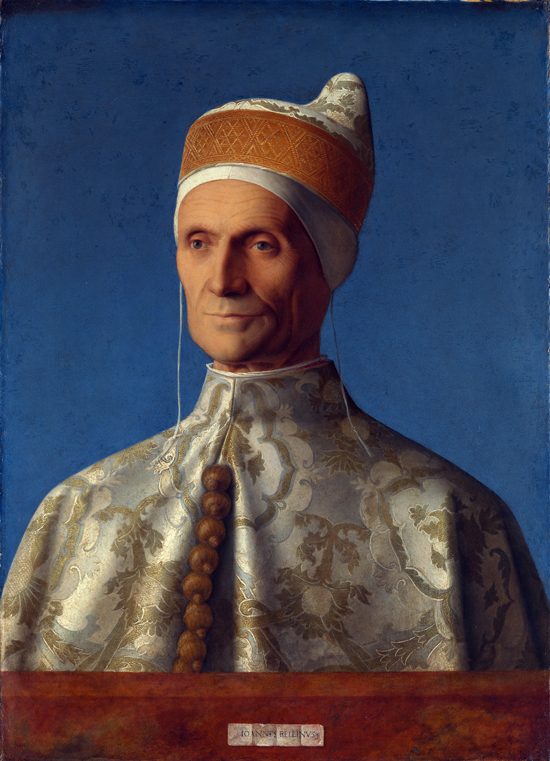
– THE DOGE, LEONARDO LOREDAN
GIOVANNI BELLINI
Norbiton has no Gothic King. No apparatus of State. No civil service, no Council of Ten.
The Ideal City has no bureaucracy of knowledge. No roles of any sort, to speak of. Nothing categorical to work with. It is peopled only by a motley of philosophes, of scratching, slouching, yawning souls.
How then can NORBITON: IDEAL CITY hope to ground itself in knowledge? Conduct an audit of its parts? Because without such a groundwork, what is a city but a sequence of accidents? Without such a groundwork, how can we invite the structures of the city to repeat themselves?
Other cities—unrooted cities, ethereal, transcendent cities—have found answers.
From the fourteenth century in Venice, the Doge could stroll in the quiet of the morning the length of his colonnade, reading, if he had the leisure and the wit, the natural history of the cosmos laid out like the pages of a book on the capitals of the thirty-six great columns which supported the upperworks of his palace[1] .
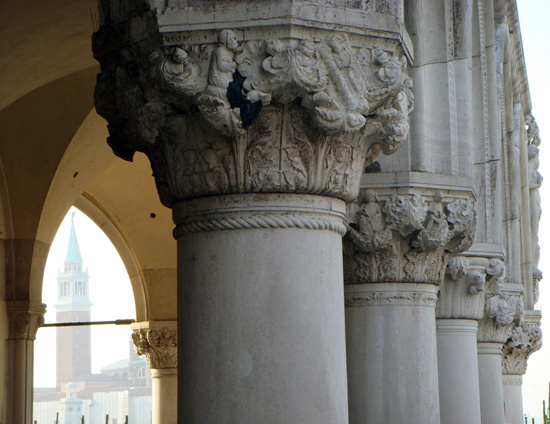
– CAPITALS ON THE PALAZZO DUCALE, VENICE
Gothic capitals, let us be clear. Each is octagonal, and each is decorated with sixteen leaves[2] , eight of which curl up to the corners, while the remaining eight curl down to reveal instantiations of various medieval taxa: planets and zodiacs, aquatic birds, deadly sins, animals of prey, beasts of burden, crafts, races of the world (Turks, Mongolians, Moors), stages of life, of paternity, virtues, vices, monarchs, monsters.
These are not charming ephemera. They are a version of the cosmos knowing itself. To the Gothic sensibility, to begin to enumerate was to invoke enumeration; to begin systematically to name, was to invoke naming; and what was the Cosmos if not creation enumerated, named, sorted?
Thus each carved figure is emblematic of a whole: we have a feline, contesting possession of a slab of honeycomb with some bees. There is a measurer, counting scoops of meal into a tub. There is a stonecutter, shaping himself out of stone.
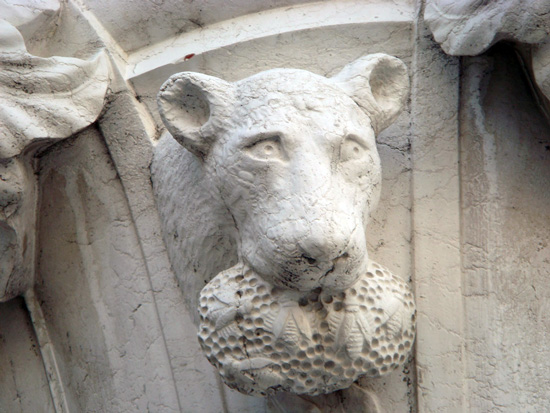
– CAPITAL ON THE PALAZZO DUCALE, VENICE
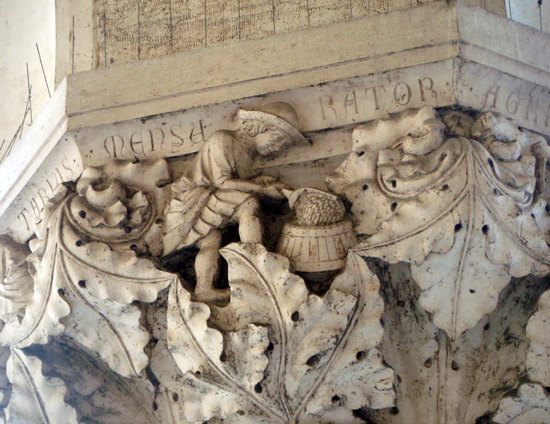
– CAPITAL ON THE PALAZZO DUCALE, VENICE
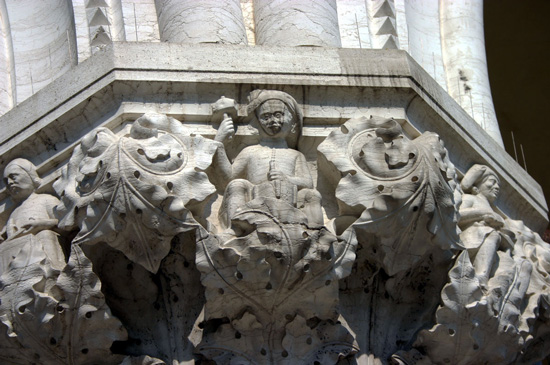
– CAPITAL ON THE PALAZZO DUCALE, VENICE
BY GIOVANNI DALL’ORTO, FROM WIKIMEDIA COMMONS
Later, across the water on the isle of San Giorgio and the Giudecca, Palladio will impatiently build his churches, San Giorgio Maggiore and the Redentore, simple white diagrams of forces. The only way to understand the Gothic, he shouts across the water, is through the classical. The classical explains the Gothic, as it explains all architecture. It may paint no pictures, but it does the math. The Cosmos? Mere ornament. And ornament can be stripped back to reveal structure. By definition, the classical knows itself because it exists by virtue of an idea.
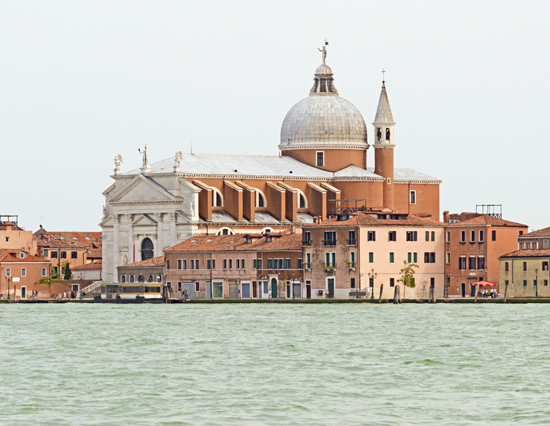
– CHIESA DEL REDENTORE, VENICE
PHOTO: CC BY-SA 4.0 (HTTPS://CREATIVECOMMONS.ORG/LICENSES/BY-SA/4.0), FROM WIKIMEDIA COMMONS
And here is the problem: to the classical, the Gothic is a mere catalogue, a garbled proliferation of instances; it needs clarifying, explaining, periodic purifying; there is an algorithm underlying all this stuff, it says, and we can show you that algorithm. In the same way, physics explains the life sciences, economics or psychology explain the city[3] .
The code, the structure, is not what you know: it is how you know. Here, says the Redentore, in this mote of extracted code, you might, if you can be bothered to run it, read the lion eating honey.
To the Gothic, conversely, the opposite held. Ruskin said of San Giorgio Maggiore that it is “impossible to conceive a design more gross, more barbarous, more childish in conception, more servile in plagiarism, more insipid in result, more contemptible under every point of rational regard”.
Ruskin saw in the Gothic a proliferation organised by an idea of God and social order, and in the neo-Classicism of Palladio a rootless play of ideas, an idle (ideal?) geometry of the soul.
Is Venice a good destination for a recovering agoraphobe? Perhaps. Perhaps not. Mrs. Isobel Easter is anyway to find out.
She tells us that she has persuaded her husband, Ted Kelley, to go there with her for a month. They are renting an apartment in the spring.
I say nothing. But I know Venice. And no city is more agora than Venice. Venice more than any other city works to a principle of a compression of space. It is a city all capillary and sluggish, clotted, tourist blood.
And it is, as Tony dell’Aquila notes with unusual perspicacity on hearing her plans, the most a-political city on the planet[4] . It is a city of people who have no possibility of assembly, of accidental or happy or frictional engagement with one another (save insofar as they get in each other’s way); no hope of protest, in other words, or celebration. It is a plasma of humanity, stripped of relations, most of them without even a place to sleep, a place to go. Anxiety defines it. It is the non-city par excellence.
But perhaps, for the agoraphobe manqué, the schizoid dilettante, there are possibilities.
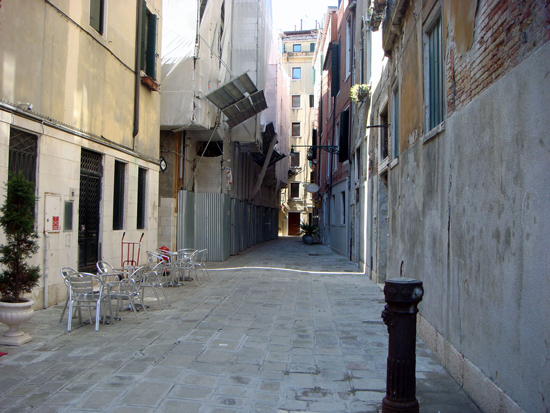
– STREET, VENICE
It is—can be—a desert city, or a crypto-city of Gothic porticos and hidden gardens.
Mrs. Isobel Easter, for example, says that she will stroll at night, criss-crossing the infinite bridges. Or she might rise at dawn and walk for an hour or two in the silent rosy streets, among the columns of the Doge’s palace, it may be, or around to the Punta della Dogana from where San Giorgio and the Redentore, the Palazzo Ducale and the Canal Grande—furred Gothic artery—are all visible; and then return to her room and, from some balcony or window over breakfast watch the crowds gather.
You do not properly see the city, she implies, from within. You must take yourself out, whether in imagination or empirical fact, to its uttermost limits, and then turn and catch it going about its business in the corner of your eye.
NON-CITY it may be, but it has IDEAL CITY written into its code.
No one will need reminding that NORBITON: IDEAL CITY is was and has been TRANSCENDENTALLY, not empirically, ideal.
The whole eternal present of its creation and destruction, from its foundation and marble uprising through its glittering heyday and its decline and fall down to the arrival of shepherds seeking shade for their flocks in its ruins, has been a transcendental project. It is, in other words, no mere fantasy or figment; it is a solid if unusual coign of vantage.
It could not have been otherwise. We marked out a morsel of land from which we might regard the Empirically Real City. We raised ourselves up, and generated ourselves an angle. We stood on a rock in the river of the Great World, or on a small rapidly eroding island, perhaps; and—carefully, exactly—noted the river’s course and strength, its tumult and lee, its patterns of sedimentation and abrasion, its scooping, delving and silting, its floods and droughts, its creaturely progress across the landscape, its teeming biome, its reeds and fishes and swarming insects, its flow of commerce and industry and electrical generation, its hypnotic self-similarity, its ribboned mouth; finally its inevitability, its incorrigibility, its unstoppableness, its rolling busyness, its roiling ever-onwardness; and now, refreshed or exhausted with knowledge and understanding, we are ready to sink once more into it, and lose ourselves in action.
But what was that rock, that island, so rapidly eroding, if not THE ANATOMY itself, chronicler of its own rise and destruction, nearing now, as it is, its categorical, alphabetical limits?
Such is the way with certain cities, certain islands. They serve their purpose.
In 1736, the mathematician Leonhard Euler published an analysis of the problem known as the Bridges of Königsberg.
The city of Königsberg is located on the Pregel River[5] , and straddles two large islands which rise in the midst of that river. In Euler’s day, the islands were joined to the mainland, and to each other, by seven bridges.
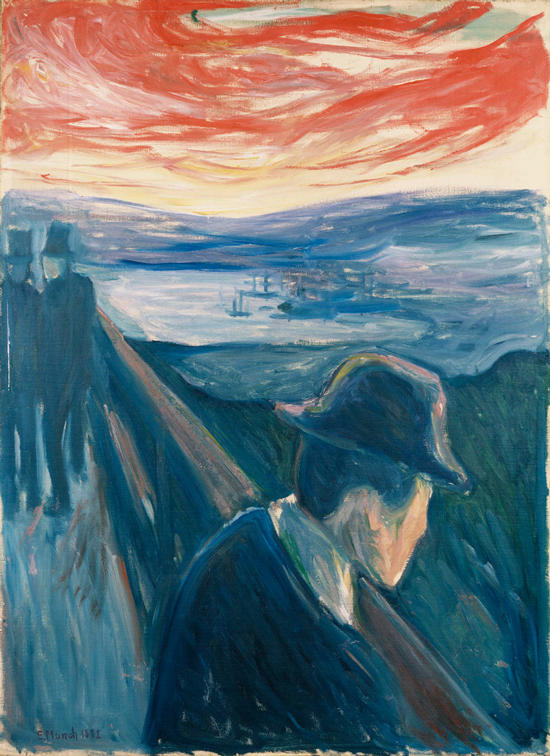
– FÖRTVIVLAN (1892)
EDVARD MUNCH
The problem was to describe a route which transversed all seven bridges once each. Any start point, and any end point, was acceptable.
Could such a route be devised? It could not, as Euler proved.
Euler reduced the problem to an analytic model, as follows: let each land mass be one vertex or node, and each bridge be one edge connecting those nodes. If any one node is not to be either the start or the end of the walk, it must be connected by an even number of edges (one to arrive, one to leave); thus at least two of the four nodes (two landmasses; two islands) must be connected by an even number of edges to all of the others. In Königsberg, this is not the case.
And in one powerful, brow-beetling sweep of thought, Euler saved himself the trouble of ever visiting Königsberg and pacing its streets in person, in an eternal wandering of empirical non-proof.
Euler was working to a principle of abstraction and simplification. He had expressed the city as a matrix of nodes and vertices. The noisy reality of stone and brick, of commerce and politics, of pedestrians halt and hale, has been at once simplified, and amplified. This is mathematics. This will be, in time, topology.
Immanuel Kant was not so swiftly placated. He walked the streets of Königsberg[6] , its bridges long since solved and abandoned, pursuing his own reputedly invariant, perfected route. I like to think that he traipsed the bridges themselves, but most likely he did not. Either way he knew that this was a city with no solution.
But he was not looking for a solution. He was, like the citizens of Norbiton, looking for an angle. An angle of thought which allowed him to see—to see, moreover, with eyes not his. To perceive the World with none of his current apparatus of perception. To stand outside himself.
The cosmos has no knowable margins. It is all interlace. How then do you push yourself out to the edge of it? How do you glimpse, not things, but the possibility of things, as they are in-themselves? Quite simply, you build a vast theoretical machine, a sprawling Critique and system of the mind, a mental contraption of levers and compartments and whirring gears and spinning lenses and shuddering mental torques and fine-tuned optical devices. A machine designed to split, to splice, and to amplify. And to throw up occasional hints of microcosmic data.
And how else would you energise such a pure and massive machine except by walking the city? Walking it endlessly, repeatedly. Why vary your walk? You will trace no solution in the stones under your feet. This imperfect walk you are on now, controlled by some invisible, theoretical barycentre: it is as good (or as bad) as any other conceivable walk. There will be no solution to it. At its conclusion, as at the conclusion of any similar walk, you will be vouchsafed no answer. But you can hope, if you apply your vast intellect assiduously enough, if your run your machine of the mind, your critique, sufficient times; you will, in imagination at least, have a sub-atomic inkling, for a trance-like fraction of a second, of what Kant came to know with trembling mysticism as the TRANSCENDENTAL STANDPOINT.
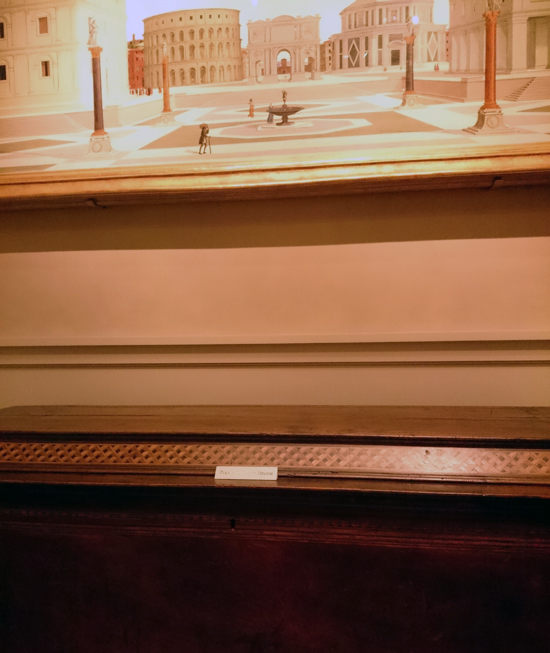
– IDEAL CITY, BALTIMORE (DETAIL)
Clarke says that the patients at Kingston Hospital where he works as an orderly could and probably do set their watches by his own perambulatory progress around the wards and corridors.
And then, when he has conceded that this is not true, that his work patterns and progresses are not nearly so regular—that he could be called at any time to move some patient or other, bed and all, to another ward, for example, or down to the morgue—he says that he was talking from the perspective of a mass observation of himself.
From a great height of hours, he says, one working day would be largely indistinguishable from another: the same paths taken, the same duties discharged. So many of the patients are anyway living their last hours sub specie aeternitatis, and Clarke, in his endless shuffling of elements and routes and rounds, dances on the edge of the singularity with them. At some point, in any given patient’s day, Clarke makes his arse-scratching appearance in his hospital greens, flatlining comments to the nurses, ignoring the patients as he might in a warehouse ignore modular shelves of merchandise; you would see him and you would not; everything flickers towards the terminus of life, and towards the sideways margins of it which you, in sickness, also graze. And here he is, this Green Man, perpetual presence, deep impersonality of the Cosmos.
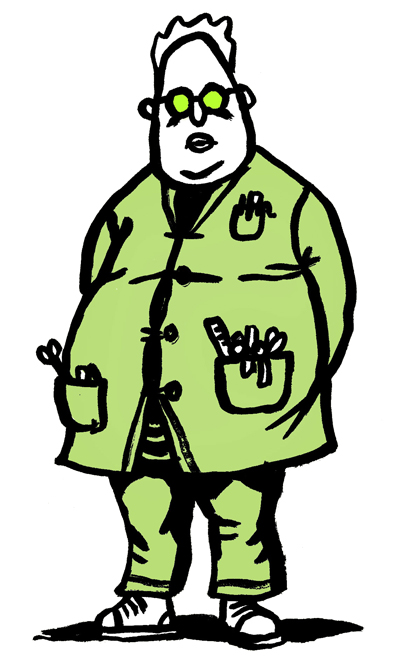
No one really has anything to say to that. We are seven: Ted Kelley and Mrs Isobel Easter; Tony dell’Aquila; Veronica di Viggiani and me; Clarke; and the ghost of Hunter Sidney. And between us, if you like, any number of bridges, connections, edges, theoreticals.
We are gathered in front of Tony dell’Aquila’s completed folly. His summer house. It is full autumn, and the last true warmth in the outside world has gone. We sit in coats and gloves and boots, drinking at Tony’s insistence coffee corrected with a little grappa. As though this were no summer house, but a winter house, a house of cold desire.
Mrs Isobel Easter, having dispensed with her news of Venice and Tony’s objections thereto, politely admires the feel of the garden (nominally, my responsibility), its barks and fruits and autumnal foreclosure. And she contrasts it wryly with the indecayable freshness of the new stone and brick and cut timber of the summer house, and with the parallel demise of her own, rotted to dull split liquid timbers not long since. Had she an adequate summerhouse, she implies, and not merely a space where a summerhouse once stood, she would not need to take herself to Venice.
But this is the way of things. A summerhouse rises, a summerhouse is torn down. Ghosts float free and away on the empty air. As though to dispel them, their lingering caress, she says to Tony, How long will this be new?
Tony says, apologetically, winning a smile from her, perhaps eighteen months.
Tony has no better answer, does not feel the drift of her question, so agog is he at his mistress’s presence; but if he stopped to think for a moment he would be able to point out that eternal freshness is a characteristic of the classical, in contrast with, say, the Gothic, or god knows the baroque; the classical is always new, since it is a-temporal, sprung from the mind of its architect, whereas the Gothic emerges slowly in time, under the hand of its masons, is corrupt, because alive, at its inception. Tony has programmed freshness into his building from the outset.
Freshness and untouchability. In a very large panel dating from around 1515 and painted for the chapel of the Guild of Saint Luke in the Sint Romboutskert, or St. Rumbold’s Church, in Mechelen, Jan Gossaert has depicted St. Luke taking the Virgin’s likeness in metalpoint[7] .
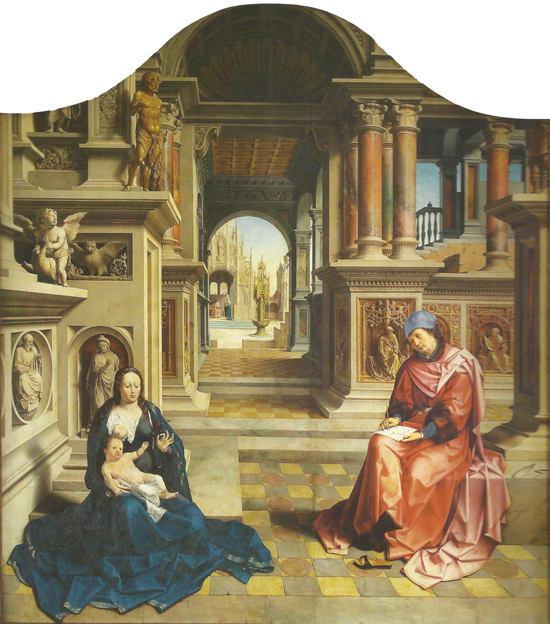
– ST. LUKE DRAWING THE VIRGIN
JAN GOSSAERT
They are lodged in an unreadable classical palace, a functionless urban space, a timeless non-city amid a fantastical confection of sculptural capitals, of polychrome pavement and scalloped and coffered ceilings, where staircases, doorways, portals lead nowhere. There are Athenian owls and a Hercules. A putto subdues a goose. There are egg-and-dart and dentils in the pediments of the column bases, acanthus in the friezes. All the paraphernalia of the antique world—classical antiquity, thus represented, has only the appearance of logical force: it signals mood music, not a train of thought.
And if we allow our eye to rove into the depths of the canvas, we see why: the guiding sensibility here is Gothic, not classical. Here we find another, miniature pair of figures: St. Luke, again, now writing his gospel, with the idealised Madonna in front of him, dictating, or otherwise inspiring.
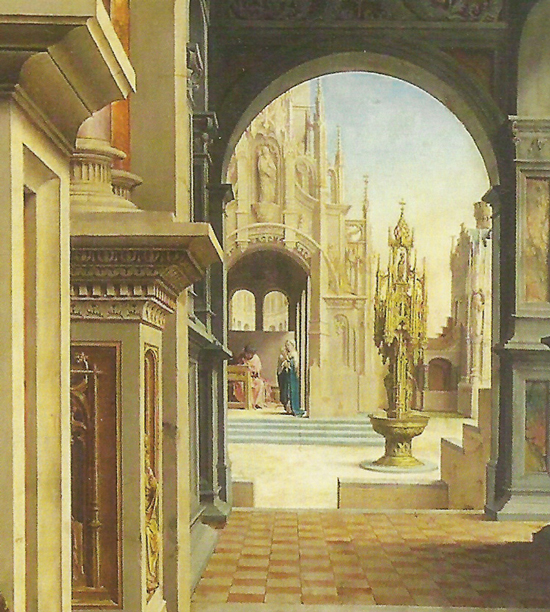
– ST. LUKE DRAWING THE VIRGIN (DETAIL)
JAN GOSSAERT
They are placed within what looks like the porch of a Netherlandish church, an overloaded Gothic fountain in front of them. All that classicism of the foreground is an acquired, not a native language. And indeed when we look again at the antique foreground we see that it is not so pure; some Gothic code is overwriting the architecture even here; saints sit in flamboyant sculptured niches next to fellow saints in pure classical frieze.
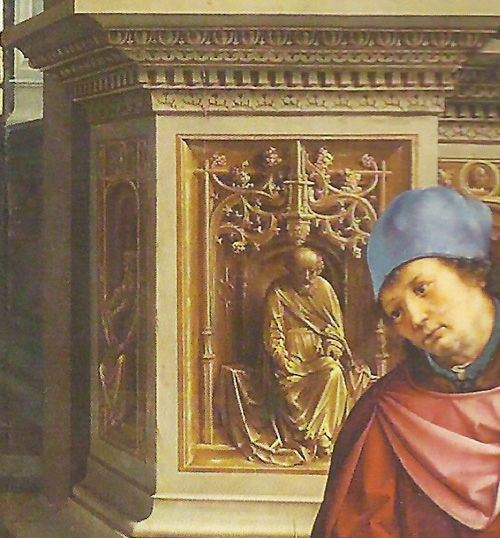
– ST. LUKE DRAWING THE VIRGIN (DETAIL)
JAN GOSSAERT
The apocryphal legend of St. Luke tells that, as the Virgin sat for her portrait, she talked of her son. Luke simultaneously took her likeness and jotted mental notes for his gospel.
What we have here then, is an exploded diagram of a single moment, necessitating a separation between the a-temporal structure of things (the classical), and the passage of time (the Gothic). Luke’s metalpoint is a record of bounding lines, of the fall of light, the how-things-are of the World; his gospel is a generative code, interlacing with other gospels, other testaments, all future (Netherlandish) lives.
And here we sit also, in the precincts of Tony’s empirically real and utterly present summer house, divided in time. Isobel Easter sits in profile to me, and smiles at Tony, but as she smiles I see the smile, not fade, but detach itself, float free of the context. She is not absent, but present elsewhere. And so too are we all: we can, if we achieve the correct mental alignment, make ourselves out across time and Richmond Park, disposed in a linked composition, around a summer house no longer there[8], all the while spinning new code in our lives.
Had I a pen, or like Luke a metal point, a graving tool, a sheet of metal to grave; had I these implements, and any talent to wield them, I would capture Isobel Easter now, in this fleeting abstraction, as the Virgin is so often captured with her young child, in a moment of prolepsis, holding rose or goldfinch, pomegranate or carnation.
In Gossaert’s painting, it is a rose, its thorns speaking of the passion to come, half a little life away. Luke sits to the Virgin’s left, studying his subject. We can just make out on the sheet on his lap that he is taking her likeness in profile, respecting the angles.
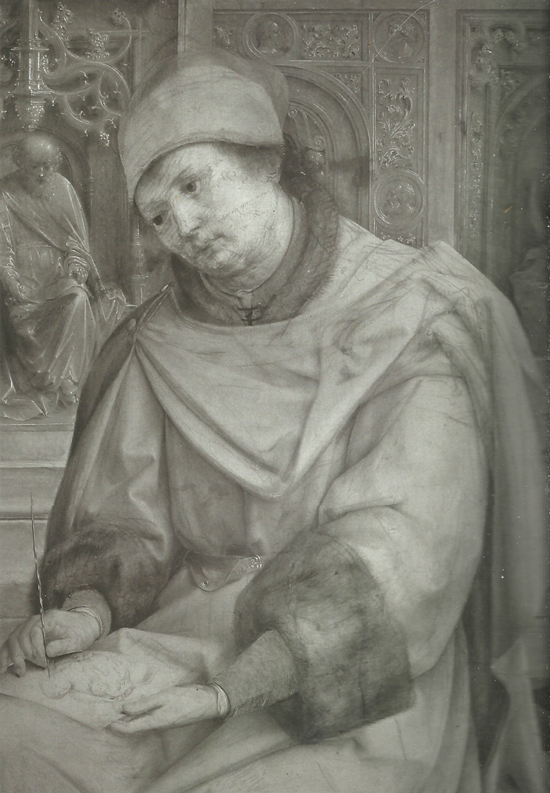
– ST. LUKE DRAWING THE VIRGIN, INFRARED REFLECTOGRAM
JAN GOSSAERT
He sets her down on paper, metal, panel, canvas, as he himself is set down in paint on oak panel; as he himself is a version, if he only knew it, of other Lukes, on other panels, drawing or painting other virgins.
How to grapple with this world of paint and representation which he inhabits, of which he is himself made? If you are to write a gospel of truth, after all, you need to be psychologically, ontologically, epistemologically, very well grounded. You cannot just make it up. Spin a story. His painting, like his gospel, is to be a faithful transcription.
Perhaps he should get up then, and wander down to the background of his world, the limits of his cosmos. There is something there which might interest him, after all: this dream or memory of himself, this doppelgänger floating free in a mobile phase, engaged, like him, on painstaking productive work, the record of a life and a soul.
He would approach, we must suppose, but never fully meet or meld with, himself. His relation to his other, productive self, is ultimately asymptotic[9] . And, like an asymptote, it is written into the structure of the reality which generates it. It is written into the code. The formula, so to speak, holds the lines apart.
Kant saw that the transcendental moment is also asymptotic, after all. Like an asymptote, it is written into our mental equations, a necessary gap. The thing you are looking for is generated by the code that does the looking; is generated and held always and necessarily at an imperceptible distance. It is an artefact of its own code. No matter how close you come, you never fully step beyond your own categories. You can only imagine their limits, in the corner of your mental eye.
Clarke muses that, circulating through the hospital as he does, shift after shift, day after day, year on year, he might be expected to leave some sort of trace. But he does not.
As a pendant to this rather bleak observation, however, he notes that on one occasion he did experience the autoscopic, or doppelgänger, effect. He was at the hospital, tired after a double shift (!), and he went to get a bite at the canteen. There was a queue for the trays, and as he walked in, he saw himself in the queue, staring back at himself. He rubbed his eyes and perhaps shook his blubbery chops, and the false-Clarke resolved into other people, empty space. It was, says Clarke, an uninteresting experience. His regulatory subsystems kicked in and sorted out the apperceptual mess, freeing him up for a bit of breakfast.
That other Clarke, we must surmise on Clarke’s behalf, was an artefact of real-Clarke’s approximative sensory apparatus; and it is worth considering that we are perhaps so inured to the welter of representations of ourselves—in mirrors, in photographs—which we experience daily, that when Clarke’s brain interpreted a confusion of signals as a representation of Clarke, it was merely locating the easiest, most probable, if also least appetising, explanation.
We all flicker thus, though we are inattentive to it. To be someone is a process, a Muybridge-strip of sensation briefly illuminated at a constantly refreshing juncture of sense data, whether relating vaguely to the outside world, or to proprioception, to the jostlings and stirrings of our inner organs as we consider breakfast; but it is a process rooted in a body placed firmly in a known and knowable world. We are all simultaneously anchored in a volume of space, and in the vestibules of our own souls.
And so, provisionally coherent, we can, if we will it, take a step, and lose ourselves for the moment in the breakfast buffet of the World.
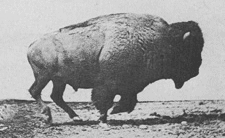
Kant may have experienced something similar on his walks, drawing ever closer to the transcendental standpoint, but never inhabiting it. Overlapping other walking versions of himself with labyrinthine precision, and with statistically important chances of success; but never quite occupying the self-same space. His thought, like his gaunt legs, was always on the move, circling rather than barking its shins on its object.
This has also been our experience in Norbiton. I got up one day and wandered down to uttermost extreme of Norbiton, and found it occupied by a little scribe, a scrawling, scribbling, version of myself. Shoe off, absorbed in some other world. I found a thing being made—the Anatomy—which spoke to, but was not of a piece with, the World, was an assemblage of disparate objects made whole. A Gothic thing.
And a failed object. However close I got, was always getting, to my object, I could never quite grasp it. The thing I was after. I was manifestly in a place, but I could never quite riddle out what I was doing there. What there was to be done. Enumerate or encode, it made little difference. There always remained some mystifying gap or other, some unbridgeable, and quite possibly generative, vacancy.
To philosophise, says Novalis[10] , is to dephlegmatise or vivify yourself. To shake off apathy.
I don’t know. That depends. It is also to fragment or, if I may, to figment yourself. The object of enquiry—whether the self or the World—is so fugitive and recalcitrant and puzzling that we inevitably capture it only in some rough-and-ready system or other. In 1501, Giovanni Bellini, great Venetian painter, teacher of great Venetian Painters, took up oils and perhaps a little egg tempera, and a poplar board, and worked up a representation in paint of the Doge, Leonardo Loredan.
Here sits the Doge, at the outset of his long and difficult reign. Somewhere, swimming in the invisible mid-range of his gaze, stands the artist. Let us hold that artist in our own long-range gaze for a moment. He pauses, looks, studies; considers scintilla of flesh, light, damask, lace; then tries to carry in porous, sieve-like neuronal structures an accurate representation of what he has seen to the canvas, where it is translated in technique learnt and adapted (as for instance the roughening of paint designed to mimic the interplay of light and thread), so that it might find some differently configured life.
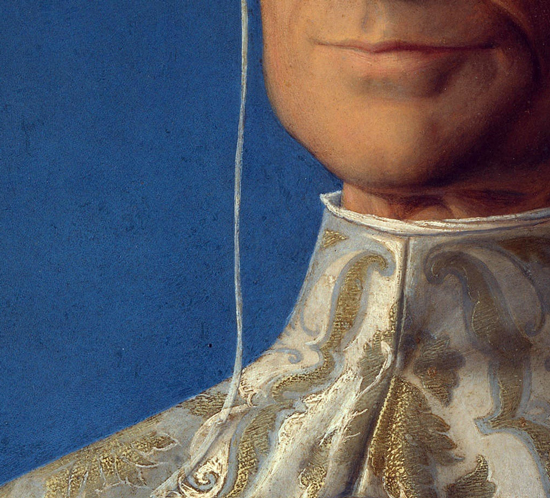
– THE DOGE LEONARDO LOREDAN (DETAIL)
GIOVANNI BELLINI
Where does the art lie, in the end? In the careful looking, in the reading of the world? Or in the working up of paint on the panel? Because the two are only tenuously linked. A tiny gulf of time yawns eternally between them, into which memory and understanding spill and slop and drain away. But that flickering eye, moving from object to panel, again and again, over and over, throws a glass bridge over the vacancy, an improbable rickety walkway of, who knows, electrons and resonances, synaptic approximations. On that side of the bridge, a Doge; on this, a fretwork of oil and pigment which will tumble down ages: a painted Doge.
How does any artist represent the Stuff of the World, in the end, if not obliquely? You might not actually do the full Kant, but you tip your hat to the master as he passes you oblivious on his itinerary of bridges. How you do this—ironically, playfully, wistfully, classically, Gothically, empirically, transcendentally—doesn’t much matter. All that matters is the fact of habitually strolling to the extreme edge of your World, whatever that canvas may be, and looking back at yourself.
When I lived in Venice, many years ago, I taught myself to avoid the routes marked for tourists by yellow signs—from the station over the Rialto to San Marco; or past the Frari to the Academia; or along the Lista di Spagna through Cannaregio to San Marco—by learning the backstreets.
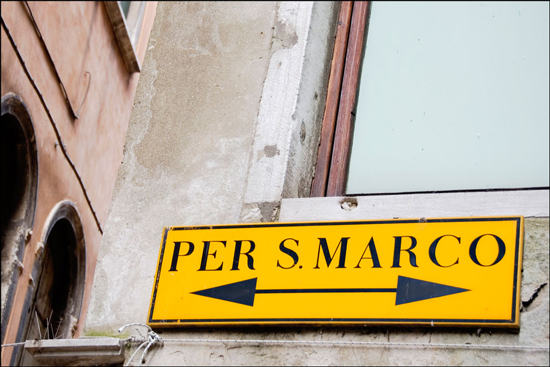
Venice is all backstreets. More precisely, named paths. Calle, salizzada, ruga, rio, ramo. Or quays. Fondamenta. Paths duck under buildings (sottoportego) cross tiny bridges, skirt palazzi. It is impossible to keep any sort of classical, linear, cartographical, geopositioning in mind. Buildings are numbered in the thousand, by sestiere, not by street. Where do you stand in relation to the Grand Canal (itself twisting through space), the Guidecca, the Redentore, St. Mark’s? Or for that matter in relation to the coast, the sun, the great curve of the sky?
You do not. You do not stand in any useful relation to those things. You have only one recourse: to learn the city by repeated walks. Thus each day I would push so far along a given route to a new bridge, and then return. The next day, I would extend the route to the next bridge, and the next, the whole walk segmented by the bridges (and turns taken at the end of bridges), as:
- THE BRIDGE OF THE FISTS
- THE TWISTED BRIDGE
- THE BRIDGE OF THE ROOFS
- THE BRIDGE OF THE SPIRES
- THE PURGATORIAL BRIDGE
- THE BRIDGE OF THE PHOENIX
- & ETC.
For a spell, in the winter, I would walk at night, escorting my architect-lover to her end of the city, and returning alone to mine. The streets were deserted, always, and I floated gently, imperceptibly, free of maps. There were only the stones and the water, nothing before me and nothing after me. Contemplation of various objects through movement, not thought. A transformational walk[11] , let us call it, to the transcendental coordinate[12]: a place not a place at all, nor even a moment, but a construct of time and place, an assembly of data and fanciful extrapolation located not or not only at the point where I was in love with the architect-woman at my shoulders or with my own little undocked life in this non-place, non-city, or perhaps with the non-city itself; but also at a point over the invisible horizon where, after accumulated Anatomies and Norbitons, I would find myself, labyrinth long-since walked, on the point of fathering a child with a woman of substance, sitting outside a summer house in winter, in the midst of a knot of people, both remembering and anticipating.
Footnotes ☞
1 “In short there is such a wondrous diversity of figures, such ubiquitous variety, that there is more reading matter available in marble than in books.” St. Bernard of Clairvaux, Apologia ad Guillelmum (1125), chap. 12 ⏎
2 Not leaves, in fact, but spatheform (spatheous? spathaceous?) bracts. ⏎
3 “See how various the forms, and how unvarying the principles.” Owen Jones, The Grammar of Ornament (1856) ⏎
4 Tony doesn’t say, precisely, ‘a-political’; he says, ‘all those fucking people, it’s a fucking Disney’ and more to that effect. But it is clear what he means. ⏎
5 Russian: Прего́ля; German: Pregel; Lithuanian: Prieglius; Polish: Pregoła ⏎
6 Imitatio Christi Book 1 Paragraph 20: “De Amore solitudinus et silentii” ⏎
7 He took her image, moreover, on a wooden table top which her son and his saviour had fashioned during his apprenticeship as a carpenter. ⏎
8 For a description of which, see Structural. ⏎
9 An asymptote is a curiosity, a straight line which continually approaches but never meets a given curve, most simply expressed, for example, as the curve y = 1/x to the x and y axes, where the axes are the asymptotes. ⏎
10 Walter Pater quotes Novalis –”Philosophiren ist delphlegmatisiren, vivificiren”– in his conclusion to Studies in the History of the Renaissance:(1873) ⏎
11 Du siehst, mein Sohn,
Zum Raum wird hier die Zeit
Gurnemanz, Parsifal, Act 1 ⏎
12 Nun achte wohl und laß mich seh’n:
bist du ein Tor und rein,
Welch Wissen dir auch mag beschieden sein
Gurnemanz, Parsifal, Act 1 ⏎
Anatomy of Norbiton on HILOBROW
Original post at Anatomy of Norbiton: Transcendental
Anatomy of Norbiton
Short Life in a Strange World by Toby Ferris
Toby Ferris on Twitter
On the Paintings of Pieter Bruegel by Toby Ferris
All tapir illustrations by Anna Keen: portfolio

